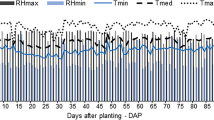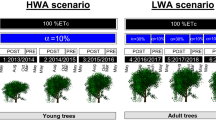Abstract
The aim of this study is to determine the water demand of the varieties RB867515, IAC91-1099, and IAC87-3396 of sugarcane using weighing lysimetry in the environmental conditions of the Cerrado of Goiás, Brazil. The experiment was conducted in Goiânia, GO, Brazil, from March 2016 to March 2018 during the cycles of plant-cane and ratoon cane, lasting 12 months each. For this purpose, 120 pots of 200 L were installed in the experimental area. Eight lines with 15 pots were spaced 1.5 m apart. Three pots were installed on electronic weighing platform scales. The soil water content was monitored by ECH2O EC-5 sensors installed in the sugarcane root zones. Irrigation was performed every two days by replenishing water in the soil up to field capacity. The water demand for the varieties IAC91-1099, RB867515, and IAC87-3396 was on average 9.2, 8.2, and 7.6 L.day−1, respectively, for the first cycle (plant-cane), and 8.4, 7.9, and 6.6 L.day−1, respectively, for the second cycle (ratoon cane). There was a decrease in water consumption of all varieties from the first to the second growing cycle. The variety RB867515 had the smallest decrease (3.7%) between cycles, followed by IAC91-1099 (8.7%), and IAC 87–3396 (13.2%). The differences in average water demand between varieties reached 17.4 and 21.4% in the first and second cycles, respectively, compared to the varieties with a greater (IAC91-1099) and lower (IAC87-3396) water demand. This is due to differences in morphological characteristics (stem diameter, stem height, number of green leaves, and leaf area), which also decreased from the first to the second cycle. There is a need to consider the variety cultivated and the cycle.





Similar content being viewed by others
References
Allen, Richard G., Luis S. Pereira, Raes Dirk, and Smith Martin. 1998. Crop Evapotranspiration: Guidelines for computing crop water requirements. Roma. FAO Irrigation and Drainage Paper 56: 300.
Antunes Júnior, E. J. Necessidade hídrica e irrigação suplementar em cana-de-açúcar no cerrado goiano. 2020. Tese (Doutorado em Agronomia) - Universidade Federal de Goiás. 130.
Bomfim, Guilherme V., Benito M. Azevedo, Thales V. A. Viana, Ronaldo L. M. Borges, and John J. G. Oliveira. 2004. Calibração de um lisímetro de pesagem após dois anos de utilização. Revista Ciência Agronômica 35: 284–290.
Cardoso, Murilo R. D., Francisco F. N. Marcuzzo, and Juliana R. Barros. 2014. Classificação climática de Köppen-Geiger para o estado de Goiás e o Distrito Federal. ACTA Geográfica 8 (16): 40–55. https://doi.org/10.5654/actageo2014.0004.0016.
Carvalho, Daniel F. D., Marcio E. D. Lima, Alexsandra D. D. Oliveira, Hermes S. D. Rocha, and José G. M. Guerra. 2012. Crop coefficient and water consumption of eggplant in no-tillage system and conventional soil preparation. Engenharia Agrícola 32 (4): 784–793. https://doi.org/10.1590/S0100-69162012000400018.
CONAB - Companhia Nacional de Abastecimento. 2019. Acompanhamento da safra brasileira de cana-de-açúcar - safra 2018/19, Fourth survery, Brasília: Conab, 75.
Franco, Iria O. 2014. Expansão da cana-de-açúcar na microrregião sudoeste de Goiás: análise espacial das mudanças do uso e cobertura do solo nos anos de 2001, 2006 e 2011. Boletim Goiano de Geografia 34(3): 481–499. https://www.redalyc.org/pdf/3371/337137823006.pdf
Gouvêa, Julia R. F., Paulo C. Sentelhas, Samuel T. Gazzola, and Marcelo C. Santos. 2009. Climate changes and technological advances: Impacts on sugarcane productivity in tropical Southern Brazil. Scientia Agricola 66 (5): 593–605. https://doi.org/10.1590/S0103-90162009000500003.
Inman-Bamber, Geoff N., and M.G. Mcglinchey. 2003. Crop coefficients and water-use estimates for sugarcane based on long-term Bowen ratio energy balance measurements. Field Crops Research 83: 125–138. https://doi.org/10.1016/S0378-4290(03)00069-8.
Inman-Bamber, Geoff N., and D.M. Smith. 2005. Water relations in sugarcane and response to water deficits. Field Crops Research 92: 185–202. https://doi.org/10.1016/j.fcr.2005.01.023.
Andrade Junior, S. Aderson, Donavan H. Noleto, Edson A. Bastos, Magna S. B. Moura, and João. C.. R. Anjos. 2017a. Demanda hídrica da cana-de-açúcar, por balanço de energia, na microrregião de Teresina Piauí. Agrometeoros 25 (1): 217–226.
Antunes Júnior, Elson J., Alves Junior, José, and Casaroli Derblai. 2018. Calibração do sensor capacitivo EC-5 em um Latossolo em função da densidade do solo. Revista Engenharia na Agricultura 26: 80–88. https://doi.org/10.13083/reveng.v26i1.864
Braga Junior, Rubens L. C., Landell, Marcos G. A, Silva, Daniel N., Bidóia, Marcio A. P., Silva, Thiago N., Thomazinho Junior, J.R., and Silva, Victor H. P. 2017. Censo varietal IAC de cana-de-açúcar na região Centro-Sul do Brasil – Safra 2016/17, Campinas: Instituto Agronômico, 40.
Landell, Marcos G. A., Campana, Mario P., Figueiredo, Pery, Zimback Leo, Silva, Marcelo A., and Prado Hélio. 1997. Novas Variedades de cana-de-açúcar, Campinas: Instituto Agronômico, 28.
Landell, Marcos G. A., Campana, Mario P., Figueiredo Pery, Xavier, Mauro A., Vasconcelos, Antonio C. M., Bidoia, Marcio A., Silva, Daniel N., Anjos, Ivan A., Prado Hélio, Pinto, Luciana R., Souza, Silvana A. C. D., Scarpari, Maximiliano S., Rosa Júnior, Vicente E., Miranda, Leila L. D., Azania, Carlos A. M., Perecin Dilermando, Rossetto Raffaela, Silva, Marcelo A., Martins, Antonio L. M., Gallo Paola, Kanthack, Ricardo A. D., Cavichioli, J.C., Veiga Filho, Alceu A., Mendonça, Jeremias R., Dias, Fabio L. F., and Garcia, Juliana C. 2007. Variedades de cana-de-açúcar para o Centro-Sul do Brasil: 16ª liberação do programa cana IAC (1959–2007), Campinas: IAC, 37.
Libardi, Luis G. P., Rogério T. Faria, Alexandre B. Dalri, Glauco S. Rolim, Luis F. Palaretti, Aderson P. Coelho, and Izabela P. Martins. 2019. Evapotranspiration and crop coefficient (Kc) of pre-sprouted sugarcane plantlets for greenhouse irrigation management. Agricultural Water Management 212: 306–316. https://doi.org/10.1016/j.agwat.2018.09.003.
Lozano, Claudia S., Rezende Roberto, Paulo S. Freitas, Tiago L. Hachmann, Fernando A. Santos, and André F. Andrean. 2017. Estimation of evapotranspiration and crop coefficient of melon cultivated in protected environment. Revista Brasileira De Engenharia Agrícola e Ambiental 21 (11): 758–762. https://doi.org/10.1590/1807-1929/agriambi.v21n11p758-762.
Manzatto, Celso V., Eduardo D. Assad, Jesus F. M. Bacca, Maria J. Zaroni, and Sandro E. M. Pereira. 2009. Zoneamento agroecológico da cana-de-açúcar: expandir a produção, preservar a vida, garantir o futuro, 55. Rio de Janeiro: Embrapa Solos.
Rossetto Raffaela, Dias, Fabio L. F., Vitti, André C., and Prado Junior, José Q. 2008. Fósforo. In Cana-de-açúcar, ed. Miranda, Leila L. D., Vasconcelos Antonio M., and Landell Marcos G.A., Campinas, 271–288.
RIDESA. Rede Interuniversitária para o Desenvolvimento do Setor Sucroalcooleiro. 2010. Catálogo nacional de variedades “RB” de cana-de-açúcar. RIDESA: Curitiba, 136.
Shikida, Pery F. A. 2013. Expansão canavieira no Centro-Oeste: limites e potencialidades. Revista De Política Agrícola 2: 122–137.
Silva, Vicente P. R., Bernardo B. Silva, Walker G. Albuquerque, Cicera J. R. Borges, Inaja F. Sousa, and Dantas Neto José. 2013. Crop coefficient, water requirements, yield and water use efficiency of sugarcane growth in Brazil. Agricultural Water Managment 128: 102–109. https://doi.org/10.1016/j.agwat.2013.06.007.
Souza, Dijalma M. G. and Lobato Edson. 2004. Correção da acidez do solo. In Cerrado: correção do solo e adubação, ed. SOUZA, Dijalma. M. G. and LOBATO Edson, Second edition, Brasília: EMBRAPA, 81–96.
Wissmann, Martin A., Graciela C. Oyamada, Claudia C. Wesendonck, and Pery F. A. Shikida. 2014. Evolução do cultivo da cana-de-açúcar na região Centro-Oeste do Brasil. Revista Brasileira De Desenvolvimento Regional 2 (1): 95–117. https://doi.org/10.7867/2317-5443.2014v2n1p095-117.
Author information
Authors and Affiliations
Corresponding author
Ethics declarations
Conflicts of interest
The authors declare no conflicts of interest.
Ethical Approval
This work does not study humans or animals.
Additional information
Publisher's Note
Springer Nature remains neutral with regard to jurisdictional claims in published maps and institutional affiliations.
Rights and permissions
About this article
Cite this article
Antunes Júnior, E.D.J., Alves Júnior, J., Evangelista, A.W.P. et al. Water Demand of Sugarcane Varieties Obtained by Lysimetry. Sugar Tech 23, 1010–1017 (2021). https://doi.org/10.1007/s12355-021-01002-5
Received:
Accepted:
Published:
Issue Date:
DOI: https://doi.org/10.1007/s12355-021-01002-5




